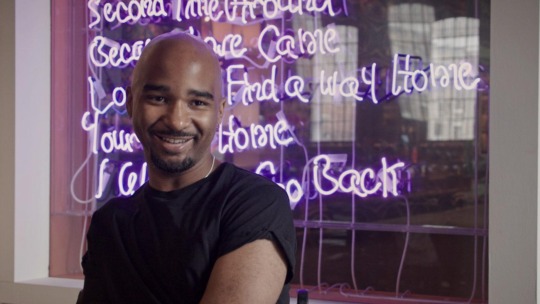
It’s tough to pull off a thematic exhibition of conceptual art in a mix of genres, but the organizers of “Extreme Weather” succeeded. Coinciding with the UN Conference on Climate Change in Paris and following the 10-year anniversary of Hurricane Katrina, this thoughtful project, which appeared at Murmur Gallery December 3 – 27, opened an engaging dialogue on a timely and difficult subject.
The exhibition was curated primarily by Meredith Kooi, a driving force behind Altered Means, a self-described “amorphous, experimental curatorial platform” that seeks new venues for displaying art in a variety of forms. This exhibition expanded the term “weather” to include the entirety of the invisible atmosphere that can exert sudden, unpredictable power over our lives. It encompasses the computing “cloud” where precious records may be stored, electronics that form the background music of our homes, and other human technologies that can silently disrupt the natural world. In keeping with the broad sense of “weather,” works appear on multiple platforms, including radio, 3-D, and online participatory videos. (Several short films are still available at Altered Means’ Facebook page.)

It’s an ambitious project that took a year to pull together, but the effort shows, starting with a gallery space nearly devoid of color except for light touches of blues and neutrals, earth and sky. The exceptions are the neon pink pops in Marcia Vaitsman’s 2012 video Impermanence, depicting 27 antennae that “eject into the sky human expectations and meanings, private and collective” (artist’s statement). Vaitsman’s piece provides ambient sound throughout the gallery, along with Valerie George’s 2010 video recording Rain Drums, in which she captures the sound of the rain “playing” drums attached to the roof of her car.

It’s astonishing how peacefully Vaitsman’s electronic blips merge with the literal drumming of the rain. That’s because technology is now deeply embedded in the environmental hum of the West. The largest piece in the exhibition, Jeff Kolar’s 2008 What Hath God Wrought?, takes us back to the origins of this phenomenon. Five photographs on vinyl banner recreate Samuel Morse’s first electronic message, sent by telegraph in 1884, and the words testify to the contradictory emotions technological change can evoke: “Isn’t this amazing? vies with “What have we done?”

This contradiction is at the heart of the exhibition, and it’s particularly apparent in two 4-by-6 photographs by Valerie Oliveiro, Electricity (2011, 2015) and Sewer (2011, 2015). Taken in Waveland, Mississippi, which has the dubious honor of being the town worst hit by both Hurricane Katrina and the BP oil spill, each depicts a marsh at evening, brown grass against bluish black sky. These empty but not abandoned home sites, marked by only a sewer connection in one and an electrical pole in another, are examples of what happens when the gentle drumming of the rain bursts into Katrina, or when machinery invisible from the shore explodes in the ocean.
The photographs also expose the fragility of not only human-developed space in the face of “weather” but also human artifacts. As she explains in her artist’s statement, Oliveiro scaled these images down for this exhibition to mimic the photographs that many Katrina survivors counted as their greatest loss. But the images also create something new that can go out into the world. Beneath the framed photographs on the wall are 100 prints, hand-signed and numbered, that visitors can take home.

Karen Tauches’s disappeared presidentz (2008) and Rachel K. Garceau’s personal safety (2015) also reveal the fragility and resilience of the things we build to protect ourselves. Tauches’s pieces are the result of work-in-progress that was damaged during a tornado that struck her Atlanta studio, while Garceau’s cracked porcelain umbrellas were “failed” attempts that broke in the heat of the kiln. For Tauches, water damage infused new life into the images, bleeding out colors and exposing previously unseen depths.
The result is as whimsical as it is artistic. That sensibility is what really makes this exhibition work. For all the seriousness of the topic, the project is joyful, even fun, and the pieces I haven’t discussed (and wish I could) will spark as much conversation for visitors as the ones mentioned here.

In her artist’s talk, Garceau said that “porcelain umbrellas are especially fragile and yet we believe they will protect us.” These cracked objects transform broken into beautiful, loss into gain. In grappling with our mutable, fragile atmosphere, “Extreme Weather” does the same.
Jami Moss Wise is a lapsed academic with a Ph.D. in English from the University of Wisconsin-Madison. She went into business full-time with her artist husband this year.




